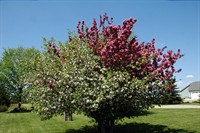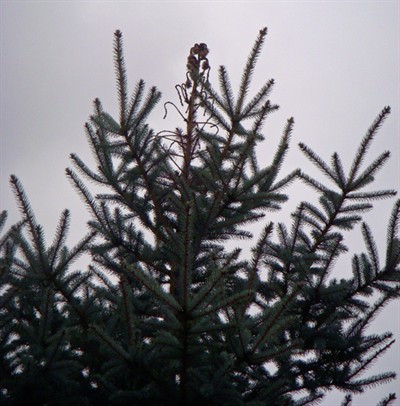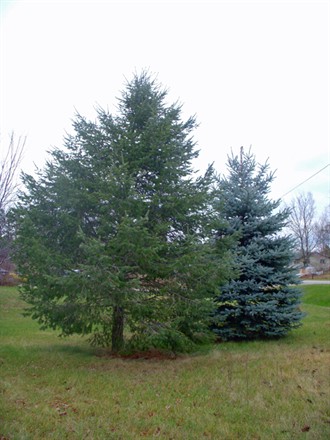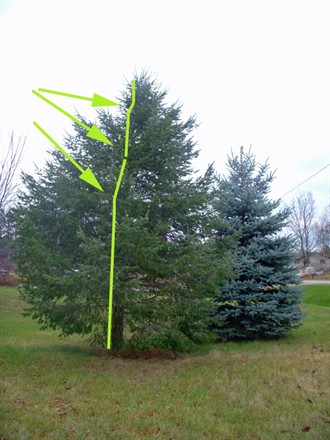Subtle change makes big difference over time
Of borers and beatin' borers
Some of the 45mph garden sights we cover are eye poppers even to
non-gardeners.
 45mph stand-out: Two-color crabapple, featured
in What's Coming Up #41.
45mph stand-out: Two-color crabapple, featured
in What's Coming Up #41.
Our headliner this time is more subtle, displaying something
even a gardener might miss. However, once you do take note of it,
you will probably find that it's more the rule than the exception.
We're talking about pyramidal evergreens such as fir and spruce
that have lost and then recovered their tip.
This example is not one of dramatic loss. Rather, it's "the
usual" for this kind of borer damage
-- loss of the top couple of feet. That's where tip borers
aim, true to their name. Sometimes, a tree can loses much more,
enough to raise the cry you might say, "Look, at that! Someone cut
the top 6 feet from that spruce rather than buy a Christmas
tree?!"
That more drastic loss might happen to a tree whose tip survives
the initial borer damage, continues to grow but ever after has a
weak spot. Later, it may break at that point, especially if some
secondary pest -- an opportunist --
moves in there where the tree's defenses are down.

Right: Here's a classic dead tip from borers tunneling into
the vertical shoot while it was soft, and continuing down for a
year.
Notice the signs that the companion spruce, too has had this
problem. It has several times lost and redeveloped a tip from a
side branch. The trunk isn't straight but has a crook at each place
where a side branch took over.
This same trunk configuration will be apparent in M.M's
tree, once a new leader develops in Fir lost its
head.


What to do to
beat spruce- or pine tip borers?
On a young (short, manageable) tree, watch for wilting of the
young leader. If you see it, cut it out during that growing season
and burn it to destroy the borer within. Nip out competing side
branches. When only a few inches is lost the development of a new
leader is quick and leaves no lasting mark.
If borers are frequently a problem, check the tree's growing
conditions -- a vigorously growing young tree should be able to
deter that. Correct drought, compacted soil, shading conditions,
etc. Treating the tree's tips early each spring at borer moth
egg-laying time can break the cycle, although the cost to you, in
an imposed extra chore, is stiff.
For some conifer contortions more certain to catch your eye,
check this.